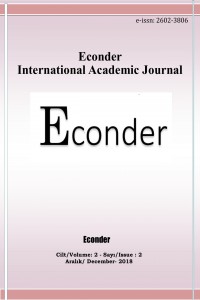Öz
Bu çalışma,
Avrupa Birliği'nde teknoloji açığının ülkeye özgü etkilerinin belirlenmesini
analiz etmeyi amaçlamaktadır. Bu nedenle bu çalışma, teknoloji açığı modelini
kullanmaktadır ve 1998-2016 dönemi için Avrupa Birliği ülkeleri için teknoloji
açığının belirleyicilerini göstermektedir. Analizde dengeli panel veri metodu
kullanılmıştır. 22 Avrupa Birliği ülkesi için teorinin ampirik testleri
sunulmaktadır. Patent başvurusundaki büyüme oranının ve kişi başına Gayri Safi
Yurtiçi Hasıla'nın büyüme oranının teknoloji açığını etkilediği bulunmuştur.
Ortak İlişkili Etki Modeli sayesinde, her ülke için bu etkileri
görebilmekteyiz. Bu, ülkeye özgü ekonomi politikasını geliştirme fırsatı
vermektedir. Bu sayede ekonomi politikası uygulayıcıları bir ekonomik
entegrasyona dahil bile olsa ülkeler, daha etkin politikalar geliştirebilirler.
Anahtar Kelimeler
Teknolojik açık Yenilik Panel Koentegrasyon Avrupa Birliği Büyüme
Kaynakça
- Blomstrom, M. (1989). Foreign investment and spillovers: A study of technology transfer to Mexico. Routledge, London.
- Castellacci, F. (2011). Closing the technology gap? Norwegian Institute of International Affairs Working Paper, 777.
- Encaoua, D. (2007). The European technology gap. Paris School of Economics, Centre Economie Sorbonne, Lecture Monte Verita Conference.
- Fagerberg, J. ve B. Verspagen (2002). Technology-gaps, innovation-diffusion and transformation: an evolutionary approach. Research Policy, 31, 1291-1304.
- Fagerberg, J. (1987). A technology gap approach to why growth rates differ. Research Policy, 16 (2-4), 87-99.
- Fagerberg, J. (1994). Technology and international differences in growth rates. Journal of Economic Literature, 32(3), 1147-1175.
- Heitger B. (1993), Comparative economic growth: Catching up in East Asia. ASEAN Economic Bulletin, 10(1), 68-82.
- Pesaran, M. H. (2004). General diagnostic tests for cross section dependence in panels. IZA Discussion Paper, 1240, 1-39.
- Pesaran, M. H. (2006). Estimation and inference in large heterogeneous panels with a multifactor error structure. Econometrica, 74(4), 967-1012.
- Pesaran, M. H. ve Yamagata, T. (2008). Testing slope homogeneity in large panels. Journal of Econometrics, 142, 50-93.
- Posner, M.V. (1961). International trade and technological change. Oxford Economic Papers, 13: 323-341.
- Schumpeter, J. (1934). The theory of economic development. Harvard University Press, Cambridge M.A.
- Solow, R. (1957). Technical change and the aggregate production function. Review of Economic Statistics. 39(3), 312-320.
- Westerlund, J. (2008). Panel cointegration tests of the Fisher Effect. Journal of Applied Econometrics, 23, 193-233.
- Williams B. R. (1968). Technology, investment and growth. Review by: Stephen Merrett. The Economic Journal, 78(310), 428-430.
Öz
This study aims to analyze the
determination of country-specific effects of technology gap in the European
Union. For this reason, this study employs technology gap model and shows that
the determinants of technology gap for the European Union countries for the
period 1998-2016. Balanced panel data method was used in the analysis. It is
presented empirical tests of the theory for 22 European Union countries. It is found that patent application
growth rate and Gross Domestic Product
per person employed growth rate effect technology gap. Owing to the Common
Correlated Effect Model we are able to see these effects for each country. This
gives the opportunity to develop country-specific economic policy. In this way, economic policy practitioners can develop more effective
policies for countries, even if they are involved in an economic integration.
Anahtar Kelimeler
Innovation Technological Gap Panel Cointegration European Union Growth
Kaynakça
- Blomstrom, M. (1989). Foreign investment and spillovers: A study of technology transfer to Mexico. Routledge, London.
- Castellacci, F. (2011). Closing the technology gap? Norwegian Institute of International Affairs Working Paper, 777.
- Encaoua, D. (2007). The European technology gap. Paris School of Economics, Centre Economie Sorbonne, Lecture Monte Verita Conference.
- Fagerberg, J. ve B. Verspagen (2002). Technology-gaps, innovation-diffusion and transformation: an evolutionary approach. Research Policy, 31, 1291-1304.
- Fagerberg, J. (1987). A technology gap approach to why growth rates differ. Research Policy, 16 (2-4), 87-99.
- Fagerberg, J. (1994). Technology and international differences in growth rates. Journal of Economic Literature, 32(3), 1147-1175.
- Heitger B. (1993), Comparative economic growth: Catching up in East Asia. ASEAN Economic Bulletin, 10(1), 68-82.
- Pesaran, M. H. (2004). General diagnostic tests for cross section dependence in panels. IZA Discussion Paper, 1240, 1-39.
- Pesaran, M. H. (2006). Estimation and inference in large heterogeneous panels with a multifactor error structure. Econometrica, 74(4), 967-1012.
- Pesaran, M. H. ve Yamagata, T. (2008). Testing slope homogeneity in large panels. Journal of Econometrics, 142, 50-93.
- Posner, M.V. (1961). International trade and technological change. Oxford Economic Papers, 13: 323-341.
- Schumpeter, J. (1934). The theory of economic development. Harvard University Press, Cambridge M.A.
- Solow, R. (1957). Technical change and the aggregate production function. Review of Economic Statistics. 39(3), 312-320.
- Westerlund, J. (2008). Panel cointegration tests of the Fisher Effect. Journal of Applied Econometrics, 23, 193-233.
- Williams B. R. (1968). Technology, investment and growth. Review by: Stephen Merrett. The Economic Journal, 78(310), 428-430.
Ayrıntılar
| Birincil Dil | İngilizce |
|---|---|
| Konular | İşletme |
| Bölüm | Makaleler |
| Yazarlar | |
| Yayımlanma Tarihi | 30 Aralık 2018 |
| Yayımlandığı Sayı | Yıl 2018 Cilt: 2 Sayı: 2 |
"Econder International Academic Journal" Ekonomi ve İşletmenin tüm yönleriyle ilgili bilimsel makaleler yayınlamaya adanmış uluslararası hakemli bir multidisipliner dergidir. Yılda iki kez çevrimiçi olarak sunulan ve yayınlanan dergide, Ekonomi ve İşletmenin tüm alanlarındaki yeni bulgular ve tartışmalar için dünyanın önde gelen platformlarından biri olmayı hedefliyoruz.





